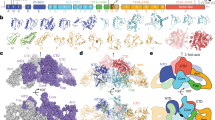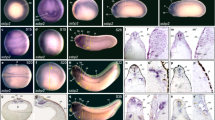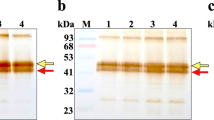Abstract
Renin, a protease which cleaves the prohormone angiotensinogen, releasing angiotensin I, has a major role in regulating blood pressure and electrolyte balance. However, the primary structure and the active structure of the enzyme remain unknown. The presence of an inactive form of the enzyme, activable by partial proteolysis, has led to the proposal that renin is synthesized as an inactive precursor1. Kidney juxtaglomerular cells constitute the principal source of renin, but its concentration in this tissue is too low to allow determination of its primary structure by conventional techniques. In some strains of mice, the male submaxillary glands synthesize and secrete very large amounts of an enzyme which appears indistinguishable from renal renin by immunological and physicochemical criteria2,3, thereby representing a unique opportunity to delineate the detailed features of renin. We now present the analysis of bacterial DNA recombinant clones harbouring an essentially complete transcript of renin mRNA isolated from the mouse submaxillary gland. The deduced amino acid sequence shows that renin is synthesized as a 44,209 molecular weight (Mr) precursor. Comparison with other known acid proteases shows a good alignment of renin and acid protease sequences in the neighbourhood of residues involved in the active site. N-terminal sequence analysis of renin reveals that the precursor is converted by a protein cleavage into active renin consisting of two chains of Mr 35,000 and 3,000.
This is a preview of subscription content, access via your institution
Access options
Subscribe to this journal
Receive 51 print issues and online access
$199.00 per year
only $3.90 per issue
Buy this article
- Purchase on SpringerLink
- Instant access to full article PDF
Prices may be subject to local taxes which are calculated during checkout
Similar content being viewed by others
References
Morris, B. J. & Lumbers, E. R. Biochim. biophys. Acta 289, 385–391 (1972).
Michelakis, A. M., Yoshida, H., Meuzie, J., Murakami, K. & Inagami, T. Endocrinology 94, 1101–1105 (1974).
Malling, C. & Poulsen, K. Biochim. biophys. Acta 491, 542–550 (1977).
Rougeon, F. et al. Proc. natn. Acad. Sci. U.S.A. 78, 6367–6371 (1981).
Maxam, A. M. & Gilbert, W. Proc. natn. Acad. Sci. U.S.A. 74, 560–564 (1977).
Sikorav, J. L., Auffray, C. & Rougeon, F. Nucleic Acids Res. 8, 3143–3155 (1980).
Davis, B. D. & Tai, P. C. Nature 283, 433–438 (1980).
Garnier, J., Gaye, P., Mercier, J. C. & Robson, B. Biochimie 62, 231–239 (1980).
Proudfoot, N. J. & Brownlee, G. G. Nature 263, 211–214 (1976).
Gross, F., Lazar, J. & Orth, H. Science 175, 656 (1972).
Misono, K. S. & Inagami, T. Biochemistry 19, 2619–2622 (1980).
James, M. N. G., Hsu, I. N. & Delbaere, L. T. J. Nature 267, 808–813 (1977).
Harboe, M. K. & Foltmann, B. FEBS Lett. 60, 133–135 (1975).
Sepulveda, P., Marciniszyn, J. Jr, Liu, D. & Tang, J. J. biol. Chem. 250, 5082–5088 (1975).
Foltmann, B., Pedersen, V. B., Jacobsen, H., Kauffman, D. & Wybrandt, G. Proc. natn. Acad. Sci. U.S.A. 74, 2321–2324 (1977).
Hsu, I. N., Delbaere, L. T. J., James, M. N. G. & Hofmann, T. Nature 266, 140–145 (1977).
Tang, J. Molec. cell. Biochem. 26, 93–109 (1979).
Soubrier, F. et al. J. clin. Endocr. Metab. 54, 139–144 (1982).
Suzuki, F., Nakamura, Y., Nagata, Y., Ohsawa, T. & Murakami, K. J. Biochem. 89, 1107–1112 (1981).
Huang, J. S., Huang, S. S. & Tang, J. J. biol. Chem. 254, 11405–11417 (1979).
Marciniszyn, J. Jr, Huang, J. S., Hartsuck, J. A. & Tang, J. J. biol. Chem. 251, 7095–7102 (1976).
Steiner, D., Quinn, P., Chan, S., Marsh, J. & Tager, H. Ann. N.Y. Acad. Sci. 343, 1–16 (1980).
Rougeon, F. & Mach, B. J. biol. Chem. 252, 2209–2217 (1977).
Dayhoff, M. O. Atlas of Protein Sequence and Structure, 105–107 (National Biochemical Research Foundation, Silver Spring, 1978).
Hunkapiller, M. W. & Hood, L. E. Biochemistry 17, 2124–2133 (1978).
Author information
Authors and Affiliations
Rights and permissions
About this article
Cite this article
Panthier, JJ., Foote, S., Chambraud, B. et al. Complete amino acid sequence and maturation of the mouse submaxillary gland renin precursor. Nature 298, 90–92 (1982). https://doi.org/10.1038/298090a0
Received:
Accepted:
Issue Date:
DOI: https://doi.org/10.1038/298090a0
This article is cited by
-
Opposite regulation of renin gene expression by cyclic AMP and calcium in isolated mouse juxtaglomerular cells
Kidney International (1995)
-
Distribution of angiotensinogen in diseased human hearts
Molecular and Cellular Biochemistry (1994)
-
DNA insertions distinguish the duplicated renin genes of DBA/2 andM. hortulanus mice
Mammalian Genome (1991)



